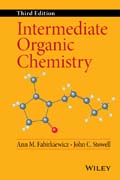
This book presents key aspects of organic synthesis stereochemistry, functional group transformations, bond formation, synthesis planning, mechanisms, and spectroscopy and a guide to literature searching in a reader–friendly manner. Helps students understand the skills and basics they need to move from introductory to graduate organic chemistry classes Balances synthetic and physical organic chemistry in a way accessible to students Features extensive end–of–chapter problems Updates include new examples and discussion of online resources now common for literature searches Adds sections on protecting groups and green chemistry along with a rewritten chapter surveying organic spectroscopy INDICE: ContentsPreface to the Second EditionPreface to the Third EditionChapter 1. Reading Nomenclature1.1 Acyclic Polyfunctional Molecules1.2 Monocyclic Aliphatic Compounds1.3 Bridged Polycyclic Structures1.4 Fused Polycyclic Compounds1.5 Spiro Compounds1.6 Monocyclic Heterocyclic Compounds1.7 Fused–Ring Heterocyclic Compounds1.8 Bridged and Spiro Heterocyclic CompoundsResourcesProblemsReferencesChapter 2. Accessing Chemical Information2.1 Databases2.2 Chemical Literature2.3 Synthetic Procedures2.4 Health and Safety InformationProblemsReferencesChapter 3. Stereochemistry3.1 Representations3.2 Vocabulary3.3 Property Differences Among Stereoisomers3.4 Resolution of Enantiomers3.5 Enantioselective Synthesis3.6 Reactions at a Stereogenic Atom3.7 Relative and Absolute Configuration3.8 TopismResourcesProblemsReferencesChapter 4. Mechanisms and Predictions4.1 Reaction Coordinate Diagrams and Mechanisms4.2 The Hammond Postulate4.3 Methods for Determining Mechanisms4.4 Representative MechanismsResourcesProblemsReferencesChapter 5. Electron Delocalization, Aromatic Character, and Pericyclic Reactions5.1 Molecular Orbitals5.2 Aromatic Character5.3 Pericyclic ReactionsResourcesProblemsReferencesChapter 6. Functional Group Transformations6.1 Carboxylic Acids and Related Derivatives6.2 Aldehydes, Ketones, and Derivatives6.3 Alcohols6.4 Ethers6.5 Alkyl Halides6.6 Amines6.7 Isocyanates6.8 Alkenes6.9 Reductive Removal of FunctionalityResourcesProblemsReferencesChapter 7. Carbon–Carbon Bond Formation7.1 Carbon–Carbon Single Bond Formation7.2 Carbon–Carbon Double–Bond Formation7.3 Multibond ProcessesResourcesProblemsReferencesChapter 8. Planning Multistep Syntheses8.1 Retrosynthetic Analysis8.2 Disconnection at a Functional Group or Branch Point8.3 Cooperation for Difunctionality8.4 Ring Closure8.5 Acetylide Alkylation and Addition8.6 The Diels–Alder Reaction8.7 The Claisen Rearrangement8.8 Synthetic Strategies8.9 Final NoteResourcesProblemsReferencesChapter 9. Physical Influences on Reactions9.1 Unimolecular Reactions9.2 Homogenous Two–Component Reactions9.3 Temperature Effects9.4 Pressure Effects9.5 Solvent Effects9.6 Biphasic Reactions9.7 Reactions on Chemical Supports9.8 Using Unfavorable Equilibria9.9 Green ChemistryResourcesProblemsReferencesChapter 10. Survey of Organic Spectroscopy10.1 Electromagnetic Radiation10.2 Ultraviolet Spectroscopy10.3 Infrared Spectroscopy10.4 Mass Spectroscopy10.5 NMR Spectroscopy10.6 Carbon NMR Spectra10.7 Correlation of 1H and 13C NMR SpectraResourcesProblemsReferencesAppendix AAppendix BIndex
- ISBN: 978-1-118-30881-3
- Editorial: Wiley–Blackwell
- Encuadernacion: Rústica
- Páginas: 352
- Fecha Publicación: 18/08/2015
- Nº Volúmenes: 1
- Idioma: Inglés
